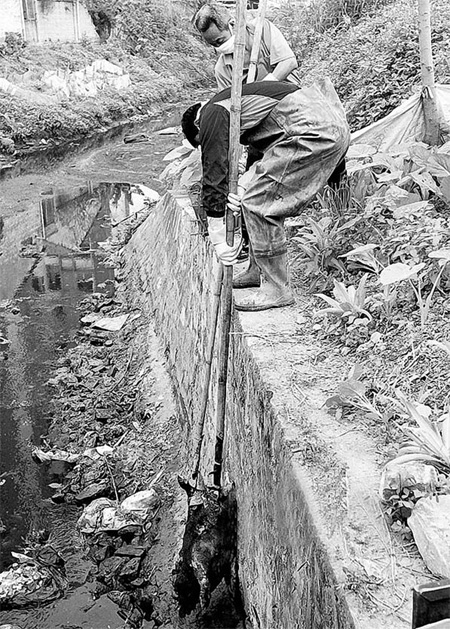Society
Pig carcasses buried amid outbreak scare
By ZHENG CAIXIONG (China Daily)
Updated: 2010-03-05 07:23
 |
Large Medium Small |
|
 Two workers pull out pig carcasses found at a riverbank under a bridge in Foshan, Guangdong province, on Tuesday. The rotting remains of more than 72 pigs were later buried.[Nanfang Metropolis Daily] |
Rotting animals 'severely polluted' rivers in suburban Foshan
GUANGZHOU: Authorities buried more than 40 pig carcasses on Thursday after the rotting remains were found in Sihui of Guangdong province, amid fears of an outbreak of foot-and-mouth disease in the city.
The carcasses were discovered under a bridge at a riverbank, said Xian Shidong, an official from the city's animal husbandry and veterinary department.
"Special personnel were immediately sent to the scene to dispose of the pigs after local residents reported the find," Xian said.
"The carcasses were also treated and the area sterilized to prevent any spread of disease."
Xian also refuted reports of an outbreak of foot-and-mouth disease in Sihui. The carcasses could have originated from outside the city, he said.
A total of 8,382 pigs were culled after a foot-and-mouth disease outbreak in the province early this month, Xinhua News Agency reported.
The National Foot-and-Mouth Disease Reference Laboratory also confirmed the outbreak, said Yu Yedong, deputy director of Guangdong's animal husbandry and veterinary bureau.
Xian's department has required operators of major pig farms and other pig farmers to vaccinate their livestock against the disease earlier this year, Xian said.
"Relevant departments are now investigating the source of the swine carcasses," Xian said.
A local farmer, who wanted to be known by his family name Chen, said the pig bodies could have been left under the city's Magang bridge for three days.
Sihui, which is under the jurisdiction of Zhaoqing city in the western part of Guangdong, is a major pig-raising base in the southern province that borders the Hong Kong and Macao special administrative regions.
Earlier this week, more than 100 pig carcasses were also found within a 500-km-long section of Gaofeng River. The remains severely polluted the water in Sanshui district of Foshan city.
Gaofeng River itself flows into Beijiang River, one of the major tributaries of the Pearl River. At least 20 pig farms are said to be located along both banks of the Gaofeng River.
He Weiquan, director of the animal epidemic prevention station under Sanshui's bureau of agriculture, said the agricultural department and local environmental protection agency as well as neighborhood and village committees are now taking measures to clean the affected areas and investigate the source of the pig carcasses.
Du Zehong, director of nearby Xinan town's animal epidemic prevention station, said the pigs might have died because of inclement and fluctuating weather in the past months.
"Many pigs were reported to have contracted respiratory diseases under the cold and moist weather in the past two months and they died after failing to receive timely treatment," Du said.
Wu Dachang, a local lawyer, said those who dumped the pig carcasses into rivers and along riverbanks have broken laws and regulations.
"Their actions have polluted the local environment and threatened public health," Wu told China Daily on Thursday.
Agricultural and relevant departments in Guangdong are doing what they can to prevent and fight the disease, Yu said.
Foot-and-mouth disease is a highly contagious and sometimes fatal illness that affects cloven-hoofed animals, including cattle, pigs, sheep and goats.







